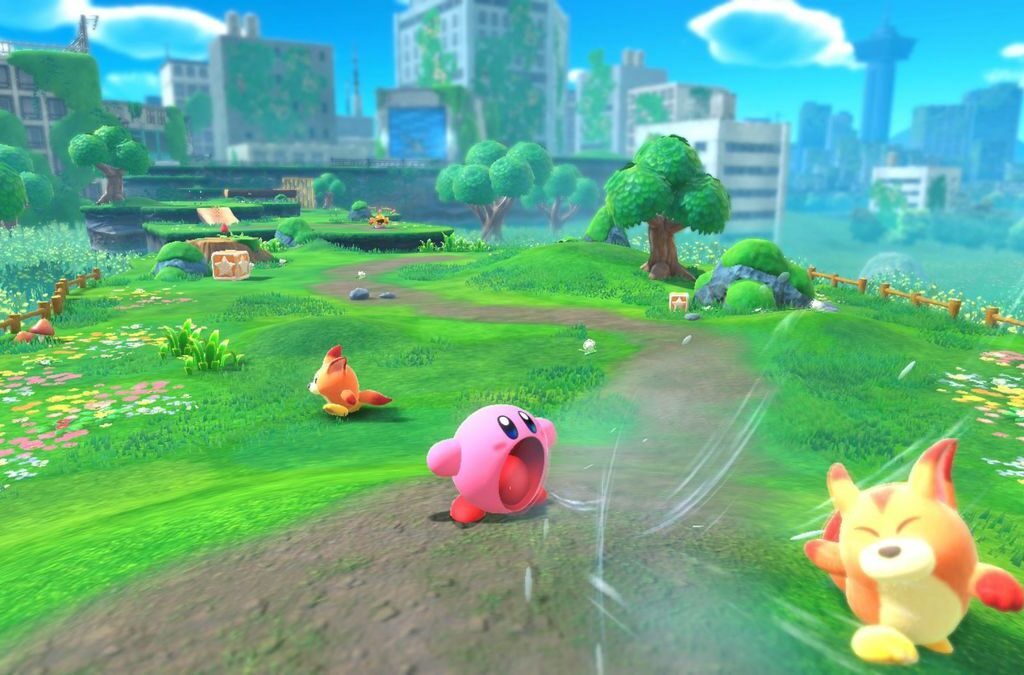Review: Kirby and the Forgotten Land
Of all Nintendo’s beloved mascots, Kirby has, for a while now, been the one who fits most awkwardly into a modern game. A character obviously designed with the limitations of the original Game Boy in mind, Kirby was, and remains, a sphere with blobby hands and feet, an uncomplicated cutie whose games tend to be easy to finish. None of this has changed for The Forgotten Land, a game that hits a lot of familiar beats and isn’t as complicated as many of Nintendo’s bigger series. But even Kirby himself doesn’t need to evolve, The Forgotten Land suggests that the games around him still can.
In Kirby and the Forgotten Land, the eponymous puffball is ripped into an alternate dimension that has clearly suffered through an apocalyptic event. Cities that seem to have been built for humans lie in ruin, and beasts stalk through each level. Signs of modernity abound, but the malls, power plants, and stretches of road you encounter are long abandoned. It’s an interesting setting for a Kirby game, and this is also the first entry in the long-running series to move the action to a 3D space. As it turns out, this is a very natural fit for the series, and The Forgotten Land feels very much of a piece with earlier Kirby adventures while also pushing new boundaries.
The gameplay is not as big a shake-up as the setting is, but there’s some refinement here. The levels are linear, with a clear start and end point, but there’s a great sense of depth to them. Kirby is tasked with rescuing his friends, the Waddle Dees, but just reaching the end of a level will only save three of the 10-or-so friends hidden in each level. The real meat of the game comes from exploration, from trying every pathway, looking for every hidden nook or cranny, figuring out the many optional puzzles throughout each level. It’s clear that a lot of thought and planning has gone into the level design – barrelling forward is still fun, but I found myself spending as much time as I could in each level, hunting for clues and taking every optional path.
As usual, Kirby is defined by his copy ability—suck up certain enemies with Kirby’s vacuum-like mouth and you’ll gain their powers, which can then be used to move through each level and hunt for secrets. The assortment of powers here will be familiar if you’ve played other Kirby games – there are swords, bombs, ice and fire, and a few others – but The Forgotten Land deepens the usual system with an extensive upgrade mechanic. By finding Blueprints scattered around each level, and then completing bespoke challenge levels for each different power-up to earn a special currency, you can unlock different forms for each weapon. The bombs, for example, can be upgraded into chain bombs that turn large areas into explosive trigger points, and then upgraded again into homing bombs that actively seek out enemies. This gives the game a great sense of progression as Kirby grows more powerful and is a great incentive to play through all the challenges, which are not only fun but a great way of learning each ability inside and out.
Totally new to The Forgotten Land is “Mouthful Mode”, which lets Kirby swallow up bigger objects and assume their shape.Kirby can take on the shape of a fast-driving car, a ground-smashing traffic cone, a can-spitting vending machine, and several others. While the uses for these different Kirby shapes end up being a little thin – the first time you use each form, you’ll basically see everything it can do – they help to give the game a greater sense of variety.
Reaching the end credits of The Forgotten Land is not difficult, but that doesn’t mean that playing through isn’t a rich experience. Completing the game 100% requires beating the more challenging post-game levels, finding all Waddle Dees, and completing numerous other activities. Kirby and the Forgotten Land is moreish enough that I found myself being drawn back after the credits rolled to try and get my completion percentage up.
You can even play through each level in two player co-op, with one player taking on the role of a spear-wielding Waddle Dee. The second player won’t have as much fun as Kirby, as they can’t use any copy abilities or mouthful mode, but it’s a great way to involve a young child or someone with less gaming experience. Since a second player can drop in or out at any time there’s no pressure to perform.
It’s a perfect fit for a series as welcoming and light as Kirby.Kirby might not be a system seller in the way Mario, Zelda, and Pokémon are, but at its best the series is rich in the same sort of Nintendo magic that those series possess. Kirby and the Forgotten Land is the best Kirby game ever made, and a great reminder that a character as simple as Kirby can still have a great deal of depth. Think of Kirby and the Forgotten Land as the talented younger brother of Super Mario Odyssey – not quite as gifted or exciting, but following in similar footsteps.
Kirby and the Forgotten Land is available now exclusively on Nintendo Switch.
James O’Connor has been reviewing games since 2008














